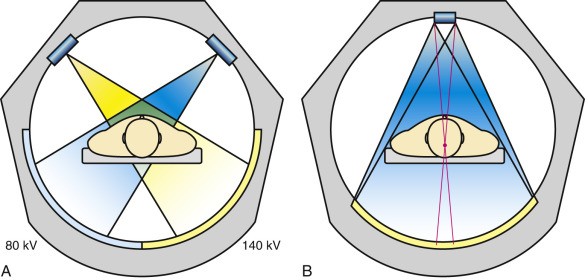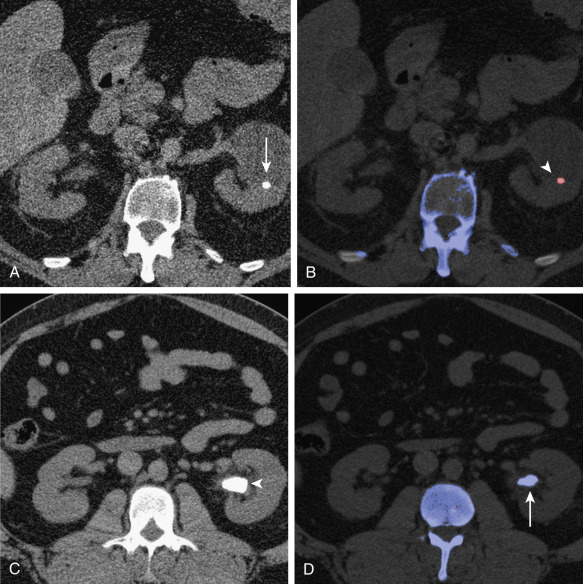Physical Address
304 North Cardinal St.
Dorchester Center, MA 02124
For almost 4 decades, computed tomography (CT) has made a remarkable impact on clinical practice. The rapid advances in both CT technology and software have widened the clinical utility of CT of the abdomen and pelvis. The benefits of multidetector CT (MDCT) over single-detector CT include increased temporal and spatial resolution, decreased image noise, and increased anatomic coverage. Better z-axis resolution and larger scan volumes result in improved multiplanar reconstruction in the coronal and sagittal planes. The reduced scanning time achieved by MDCT also helps reduce respiratory and motion artifacts.
Perfusion CT is an exciting CT innovation that allows functional evaluation of tissue vascularity. This technique has many potential applications in abdominopelvic oncologic imaging. Dual-energy CT , using either a single source (single x-ray tube) or dual source (dual x-ray tube), is another advance that shows promise for a broad spectrum of abdominal and pelvic applications. Other developments include scanners with 256 or 320 detector rows, superior detector materials (gemstone detector technology), volume or helical shuttle mode techniques, and use of dose reduction iterative reconstruction algorithms. In this chapter an overview is provided of the recent advances in CT with emphasis on clinical applications.
Several advances in the x-ray tube in the past few years have enabled CT to broaden its utility in the realm of cardiac imaging and in tissue material differentiation ( Table 7-1 ). One of the best-known advancements has been the introduction of dual-source CT (Somatom Definition, Siemens Medical Solutions, Forchheim, Germany). Dual-source CT contains two sets of x-ray tube and detector arrays, which are arranged in a single gantry perpendicular (90 degrees) to each other in the x-y plane ( Figure 7-1, A ). Dual-source CT has three main advantages over the single-source scanners, depending on the mode of scan acquisition. Operating the two tubes at different tube potentials allows dual-energy scanning and thus has applications in tissue differentiation. When the two x-ray tubes are used in unison at equal tube potentials, the resultant increased photon flux permits scanning larger patients with acceptable noise. The third, and most explored, capability of dual-source CT is the improved temporal resolution achieved by the use of two x-ray tubes. By using the two tubes at identical kilovoltage peak levels, it is possible to acquire images using data from only 90 degrees of gantry rotation instead of the conventional 180 degrees of data required for the single-source CT. The resultant temporal resolution of only 83 ms is particularly advantageous in coronary artery imaging. It is possible to obtain diagnostic images at higher heart rates than previously possible and possibly obviate the need for beta-adrenergic blockers.
| GE Discovery 750HD | Phillips Brilliance CT | Siemens Flash | Toshiba One | |
|---|---|---|---|---|
| Rows (n × mm) | 64 × 0.625 | 128 × 0.625 256 × 0.625 |
2 × 64 × 0.6 | 320 × 0.5 |
| Width (cm) | 4 | 8/16 | 3.8 | 16 |
| Channels (n) | 64 | 256/512 | 2 × 128 | 320 |
| Tube power (kW) | 100 | 120 | 2 × 100 | 72 |
| Maximum current (mA) | 800 | 950 | 2 × 850 | 600 |
| Gantry rotation (ms) | 350 | 270 | 280 | 350 |
| Temporal resolution (ms) | 175 | 135 | 75 | 175 |

Dual-energy scanning also can be performed using single-source CT by rapid voltage and milliampere modulation (see Figure 7-1, B ). This technique may achieve dual-energy processing using projection data acquired in both axial and helical modes, unlike the image-based dual-energy processing of dual-source CT. Theoretically, this permits accurate material decomposition and monochromatic CT image display, which should potentially facilitate more precise tissue characterization and also substantially decrease image artifacts. Two disadvantages of single-source dual-energy scanning are the unequal noise levels that may result in the data sets owing to the rapid modulation of tube current and the fact that the use of the same filtration for the two energy beams may result in suboptimal spectral separation.
Owing to their differing electron configurations, the atoms of different elements absorb x-rays with different frequency signatures. This phenomenon can be used, with limitations, to identify the elemental makeup of compounds, including calcium density in bones, to differentiate plaque from contrast-enhanced vessel lumen, to assess tissue fat, and to differentiate calcium and uric acid stones. The ability of dual-energy CT to qualitatively and quantitatively assess calcium content has been used to assess urinary stones and bone density more reliably than single-energy techniques. The introduction of dual-source CT scanners has facilitated concurrent scanning with two different energy levels, avoiding even small misregistration artifacts. The practical utility of DECT is likely to be enhanced by the introduction of rapid kilovoltage switching as another approach for dual-energy scanning. A third approach also exists as an alternative for dual-energy scanning that involves a sandwich detector: the low-energy photons are absorbed in the top layers of the detector, and the higher energy photons are absorbed in the lower levels of the detector.
For most clinical applications, dual-energy scanning is performed at the tube potentials of 80 and 140 kVp, which allows for optimum tissue material differentiation because the quality of dual-energy postprocessing is inversely related to the overlap of the spectra, which is least at these two energies.
Virtual unenhanced images : Reconstruction of the 80 kVp and 140 kVp image data sets allows generation of “virtual unenhanced images” that may preclude the routine need for true unenhanced acquisitions. Thus, a dual-energy contrast-enhanced acquisition could yield both unenhanced and contrast-enhanced CT images and therefore diminish radiation dose exposure to the patients.
Determination of stone composition: Dual-energy CT is a robust technique to determine the composition of urinary stones, particularly the differentiation of uric acid from non–uric acid stones, which has implications for treatment ( Figure 7-2 ). Uric acid stones may be treated with urinary alkalinization as a first-line treatment, whereas non–uric acid stones are usually treated by lithotripsy or surgically.

Evaluation of renal masses: Dual-energy scanning can be used to generate a color-coded image that shows the distribution of iodine within a particular tissue. These iodine-based maps are sensitive for the detection of subtle enhancement and may be used to differentiate high-density benign cysts from solid renal masses.
Evaluation of adrenal masses: In a study performed by Gnannt and associates, good accuracy of virtual unenhanced images generated on dual-source, dual energy CT (dsDECT) was demonstrated in a study evaluating 42 patients with 51 lesions. Using conventional unenhanced CT as a reference, the sensitivity, specificity, and accuracy for dsDECT virtual unenhanced images for classifying a lesion greater than 1 cm as probably benign were 95, 100, 97%, and 91, 100, 95%, respectively, for two independent readers.
Evaluation of the pancreas: To evaluate pancreatic adenocarcinoma using DECT, Patel and colleagues looked at a group of 65 patients. They compared 70-keV images to contrast-to-noise ratio (CNR)-optimized 45-keV images. The statistically significant increase of lesion contrast at the CNR-optimized kilovoltage was almost double that of the 70-keV image.
CT angiography: Dual-energy techniques may be used for rapid and accurate removal of bony structures and calcified plaques during postprocessing of CT angiographic images. DECT angiography examination reduces radiation dose by 20% to 30%.
Other applications: These include use of iodine maps for liver lesion characterization. Emerging indications for DECT in the gut include improved detection of bowel ischemia, evaluation of alternative contrast agents, and improved methods of electronic cleansing during CT colonography.
Currently, 64-slice CT scanners are the preferred MDCT technology. The detector widths in the currently available 64-slice CT scanners range from 2.8 to 4 cm and allow acquisition of slices with widths ranging from 0.5 to 0.625 mm. Reformatting of images in orthogonal planes is possible with isotropic resolution. The craniocaudal coverage of the 64-slice scanners is limited to 3.2 to 4.0 cm, which restricts cine imaging over a wider coverage area. Because the value of CT in the realm of functional imaging is gradually increasing, it is desirable to have a wider coverage area for cine imaging. This has led to the emergence of newer CT scanners with wider detector arrays with increasing numbers of rows.
The latest entrants to the CT arena are scanners with a number of detectors in excess of 100 (128, 256, and 320), which eliminate the need for spiral scanning and has the potential to achieve a “single-shot” scan. The 128-slice scanner has a fluid metal-cooled x-ray tube and a 128-row detector array with coverage of 8 cm at 0.625 mm thickness (see Table 7-1 ). Whereas the spiral scanning option with this CT allows a coverage of 8 cm, operating in the joggle mode (i.e., back-and-forth movements of the two table positions) helps expand the effective coverage for dynamic imaging. The 256-slice CT scanner is able to achieve an isotropic resolution of less than 0.5 mm for a wide craniocaudal coverage in one rotation. The 320-slice dynamic volume CT scanner has a gantry with an aperture of 70 cm and a 70-kW x-ray tube with detector width of 16 cm along the rotational axis of the gantry. The scanner has 320 rows of 0.5-mm-thick detector elements. The wide detector coverage (16 cm) makes it possible to scan the entire heart without table motion and has the potential to allow dynamic imaging over a single heartbeat. This scanner also may allow functional assessment of entire organs or large tumors.
Become a Clinical Tree membership for Full access and enjoy Unlimited articles
If you are a member. Log in here